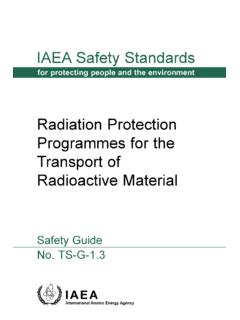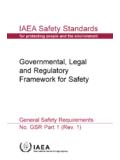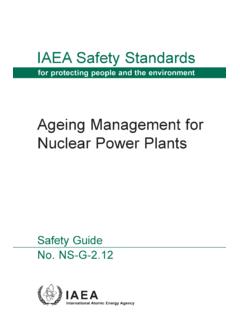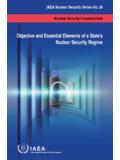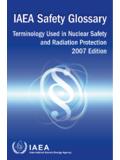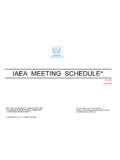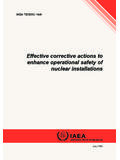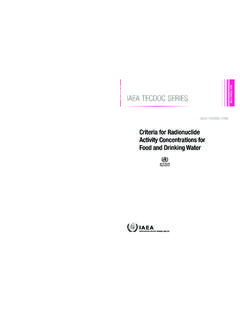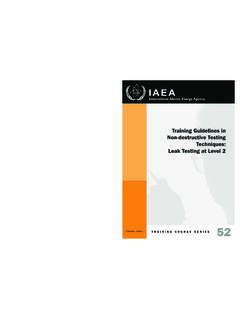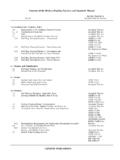Transcription of IAEA SAFETY STANDARDS SERIES
1 IAEASAFETYSTANDARDSSERIESFire SAFETY in theOperation of NuclearPower PlantsSAFETY GUIDENo. ATOMIC ENERGY AGENCYVIENNAIAEA SAFETY RELATED PUBLICATIONSIAEA SAFETY STANDARDSU nder the terms of Article III of its Statute, the iaea is authorized to establish standardsof SAFETY for protection against ionizing radiation and to provide for the application of thesestandards to peaceful nuclear regulatory related publications by means of which the iaea establishes safetystandards and measures are issued in the iaea SAFETY STANDARDS SERIES . This SERIES coversnuclear SAFETY , radiation SAFETY , transport SAFETY and waste SAFETY , and also general SAFETY (thatis, of relevance in two or more of the four areas), and the categories within it are SafetyFundamentals, SAFETY RequirementsandSafety Fundamentals(blue lettering) present basic objectives, concepts and principles ofsafety and protection in the development and application of nuclear energy for Requirements(red lettering) establish the requirements that must be met to ensuresafety.
2 These requirements, which are expressed as shall statements, are governed bythe objectives and principles presented in the SAFETY Fundamentals. SAFETY Guides(green lettering) recommend actions, conditions or procedures for meetingsafety requirements. Recommendations in SAFETY Guides are expressed as should state-ments, with the implication that it is necessary to take the measures recommended orequivalent alternative measures to comply with the iaea s SAFETY STANDARDS are not legally binding on Member States but may beadopted by them, at their own discretion, for use in national regulations in respect of their ownactivities. The STANDARDS are binding on the iaea in relation to its own operations and on Statesin relation to operations assisted by the on the iaea s SAFETY STANDARDS programme (including editions in languagesother than English) is available at the iaea Internet site or on request to the SAFETY Co-ordination Section, iaea , Box 100, A-1400 Vienna, SAFETY RELATED PUBLICATIONSU nder the terms of Articles III and of its Statute, the iaea makes available andfosters the exchange of information relating to peaceful nuclear activities and serves as an inter-mediary among its Member States for this on SAFETY and protection in nuclear activities are issued in other SERIES , inparticular the iaea SAFETY Reports SERIES , as informational publications.
3 SAFETY Reports maydescribe good practices and give practical examples and detailed methods that can be used tomeet SAFETY requirements. They do not establish requirements or make iaea SERIES that include SAFETY related sales publications are the TechnicalReports SERIES ,theRadiological Assessment Reports SERIES and the INSAG SERIES . TheIAEA also issues reports on radiological accidents and other special sales SAFETY related publications are issued in the TECDOC SERIES , the Provisional SafetyStandards SERIES , the Training Course SERIES ,the iaea Services Seriesand the ComputerManual SERIES , and as Practical Radiation SAFETY Manuals and Practical RadiationTechnical Manuals. FIRE SAFETY IN THE OPERATIONOF NUCLEAR POWER PLANTSThe following States are Members of the International Atomic Energy Agency:AFGHANISTANALBANIAALGERIAANGOLAAR GENTINAARMENIAAUSTRALIAAUSTRIABANGLADESH BELARUSBELGIUMBENINBOLIVIABOSNIA AND HERZEGOVINABRAZILBULGARIABURKINA FASOCAMBODIACAMEROONCANADACHILECHINACOLO MBIACOSTA RICACOTE D IVOIRECROATIACUBACYPRUSCZECH REPUBLICDEMOCRATIC REPUBLICOF THE CONGODENMARKDOMINICAN REPUBLICECUADOREGYPTEL SALVADORESTONIAETHIOPIAFINLANDFRANCEGABO NGEORGIAGERMANYGHANAGREECEGUATEMALAHAITI HOLY SEEHUNGARYICELANDINDIAINDONESIAIRAN, ISLAMIC REPUBLIC OF IRAQIRELANDISRAELITALYJAMAICAJAPANJORDAN KAZAKHSTANKENYAKOREA.
4 REPUBLIC OFKUWAITLATVIALEBANONLIBERIALIBYAN ARAB JAMAHIRIYALIECHTENSTEINLITHUANIALUXEMBOU RGMADAGASCARMALAYSIAMALIMALTAMARSHALL ISLANDSMAURITIUSMEXICOMONACOMONGOLIAMORO CCOMYANMARNAMIBIANETHERLANDSNEW ZEALANDNICARAGUANIGERNIGERIANORWAYPAKIST ANPANAMAPARAGUAYPERUPHILIPPINESPOLANDPOR TUGALQATARREPUBLIC OF MOLDOVAROMANIARUSSIAN FEDERATIONSAUDI ARABIASENEGALSIERRA LEONESINGAPORESLOVAKIASLOVENIASOUTH AFRICASPAINSRI LANKASUDANSWEDENSWITZERLANDSYRIAN ARAB REPUBLICTHAILANDTHE FORMER YUGOSLAV REPUBLIC OF MACEDONIATUNISIATURKEYUGANDAUKRAINEUNITE D ARAB EMIRATESUNITED KINGDOM OF GREAT BRITAIN AND NORTHERN IRELANDUNITED REPUBLICOF TANZANIAUNITED STATES OF AMERICAURUGUAYUZBEKISTANVENEZUELAVIET NAMYEMENYUGOSLAVIAZAMBIAZIMBABWEThe Agency s Statute was approved on 23 October 1956 by the Conference on the Statute of theIAEA held at United Nations Headquarters, New York; it entered into force on 29 July 1957. TheHeadquarters of the Agency are situated in Vienna. Its principal objective is to accelerate and enlarge thecontribution of atomic energy to peace, health and prosperity throughout the world.
5 iaea , 2000 Permission to reproduce or translate the information contained in this publication may beobtained by writing to the International Atomic Energy Agency, Wagramer Strasse 5, Box 100,A-1400 Vienna, by the iaea in AustriaJuly 2000 STI/PUB/1091 FIRE SAFETY IN THE OPERATIONOF NUCLEAR POWER PLANTSSAFETY GUIDESAFETY STANDARDS SERIES No. ATOMIC ENERGY AGENCYVIENNA, 2000 VIC Library Cataloguing in Publication DataFire SAFETY in the operation of nuclear power plants : SAFETY guide. Vienna :International Atomic Energy Agency, ; 24 cm. ( SAFETY STANDARDS SERIES , ISSN 1020 525X ; no. )STI/PUB/1091 ISBN 92 0 100900 3 Includes bibliographical Nuclear power plants Fires and fire InternationalAtomic Energy 00243 FOREWORDby Mohamed ElBaradeiDirector General One of the statutory functions of the iaea is to establish or adopt STANDARDS ofsafety for the protection of health, life and property in the development andapplication of nuclear energy for peaceful purposes, and to provide for the applicationof these STANDARDS to its own operations as well as to assisted operations and, at therequest of the parties, to operations under any bilateral or multilateral arrangement,or, at the request of a State, to any of that State s activities in the field of following advisory bodies oversee the development of SAFETY STANDARDS : theAdvisory Commission for SAFETY STANDARDS (ACSS); the Nuclear SAFETY StandardsAdvisory Committee (NUSSAC).
6 The Radiation SAFETY STANDARDS AdvisoryCommittee (RASSAC); the Transport SAFETY STANDARDS Advisory Committee(TRANSSAC); and the Waste SAFETY STANDARDS Advisory Committee (WASSAC).Member States are widely represented on these order to ensure the broadest international consensus, SAFETY STANDARDS arealso submitted to all Member States for comment before approval by the iaea Boardof Governors (for SAFETY Fundamentals and SAFETY Requirements) or, on behalf of theDirector General, by the Publications Committee (for SAFETY Guides).The iaea s SAFETY STANDARDS are not legally binding on Member States but maybe adopted by them, at their own discretion, for use in national regulations in respectof their own activities. The STANDARDS are binding on the iaea in relation to its ownoperations and on States in relation to operations assisted by the iaea . Any Statewishing to enter into an agreement with the iaea for its assistance in connectionwith the siting, design, construction, commissioning, operation or decommissioningof a nuclear facility or any other activities will be required to follow those parts of thesafety STANDARDS that pertain to the activities to be covered by the , it should be recalled that the final decisions and legal responsibilities in anylicensing procedures rest with the the SAFETY STANDARDS establish an essential basis for SAFETY , theincorporation of more detailed requirements, in accordance with national practice,may also be necessary.
7 Moreover, there will generally be special aspects that need tobe assessed by experts on a case by case physical protection of fissile and radioactive materials and of nuclearpower plants as a whole is mentioned where appropriate but is not treated in detail;obligations of States in this respect should be addressed on the basis of the relevantinstruments and publications developed under the auspices of the aspects of industrial SAFETY and environmental protection are alsonot explicitly considered; it is recognized that States should fulfil their internationalundertakings and obligations in relation to requirements and recommendations set forth in the iaea SAFETY standardsmight not be fully satisfied by some facilities built to earlier STANDARDS . Decisions onthe way in which the SAFETY STANDARDS are applied to such facilities will be taken byindividual attention of States is drawn to the fact that the SAFETY STANDARDS of theIAEA, while not legally binding, are developed with the aim of ensuring that thepeaceful uses of nuclear energy and of radioactive materials are undertaken in amanner that enables States to meet their obligations under generally acceptedprinciples of international law and rules such as those relating to environmentalprotection.
8 According to one such general principle, the territory of a State must notbe used in such a way as to cause damage in another State. States thus have anobligation of diligence and standard of nuclear activities conducted within the jurisdiction of States are, as anyother activities, subject to obligations to which States may subscribe under inter-national conventions, in addition to generally accepted principles of international are expected to adopt within their national legal systems such legislation(including regulations) and other STANDARDS and measures as may be necessary to fulfilall of their international obligations NOTEAn appendix, when included, is considered to form an integral part of the standard andto have the same status as the main text. Annexes, footnotes and bibliographies, if included, areused to provide additional information or practical examples that might be helpful to the SAFETY STANDARDS use the form shall in making statements about requirements,responsibilities and obligations.
9 Use of the form should denotes recommendations of adesired English version of the text is the authoritative ..1 Background ( ) ..1 Objective ( ) ..1 Scope ( ) ..1 Structure ( ) .. OF DEFENCE IN DEPTH ..3 Defence in depth ( ) ..3 Design ( ) ..4 Fire SAFETY management ( ) ..4 Fire prevention and fire protection ( ) ..5 Quality assurance ( ) ..6 Emergency arrangements ( ) .. AND RESPONSIBILITIES ( ) .. UPDATING OF THE FIRE HAZARDANALYSIS ( ) .. OF PLANT MODIFICATIONS ON FIRE SAFETY ( ) OF COMBUSTIBLE MATERIALS AND IGNITIONSOURCES ..10 Control of combustible materials ( ) ..10 Control of ignition sources ( ) .. , MAINTENANCE AND TESTING OF FIREPROTECTION MEASURES ( ) .. FIRE FIGHTING CAPABILITY ( ) .. OF PLANT PERSONNEL ( ) .. ASSURANCE FOR MATTERS RELATING TO FIRESAFETY ( ) ..19 ANNEX: FIRE PROTECTION MEASURES FOR INCLUSIONIN THE INSPECTION, MAINTENANCE AND TESTINGPROGRAMME ..21 GLOSSARY.
10 29 REFERENCES ..30 CONTRIBUTORS TO DRAFTING AND REVIEW ..31 ADVISORY BODIES FOR THE ENDORSEMENT OF SAFETYSTANDARDS ..3311. Operational experience gained from incidents in nuclear power plants aroundthe world has continued to demonstrate the vulnerability of SAFETY systems to fire andits effects. Considerable developments have taken place in recent years in the designof and regulatory requirements for fire SAFETY in operating nuclear power plants,resulting in substantial improvements at many plants. If these improvements are to bemaintained, a systematic approach to fire SAFETY is necessary for both plants built tomodern STANDARDS and those built to earlier STANDARDS . Some iaea SAFETY STANDARDS have addressed fire SAFETY as a design of the relevant SAFETY Requirements publication [1] giverequirements for fire SAFETY in the design of nuclear power plants and a related SafetyGuide [2] provides guidance on meeting those requirements.
